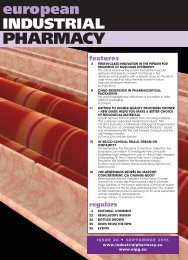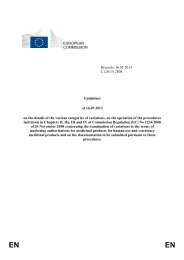PHARMACY
eip31-dec16
eip31-dec16
Create successful ePaper yourself
Turn your PDF publications into a flip-book with our unique Google optimized e-Paper software.
REGENERATIVE MEDICINE:<br />
ENERGISING TECHNOLOGY<br />
EVOLUTION TOWARDS<br />
FUTURE MEDICINE<br />
by Cecilia Van Cauwenberghe and Sudeep Basu<br />
Although still demanding more specialisation for both<br />
scientists and clinicians, regenerative medicine is<br />
destined to address the most concerning challenges of<br />
current medical therapies.<br />
Cecilia Van Cauwenberghe (cecilia.vancauwenberghe@frost.com), PhD, is an Associate<br />
Fellow, Innovation Services in the TechVision Group at Frost & Sullivan.<br />
Sudeep Basu, PhD, is Global Practice Leader, Innovation Services in the TechVision Group<br />
at Frost & Sullivan.<br />
Focus area 1: Technology<br />
synergy<br />
What are the most prospective<br />
technologies empowering<br />
regenerative medicine?<br />
Developments in stem cell<br />
technology and tissue engineering<br />
combine advanced biomaterials with<br />
small molecules and biologics to<br />
replace or regenerate human tissues<br />
and organs and restore their<br />
functions. Regenerative medical<br />
approaches represent perhaps the<br />
most valuable technological<br />
synergies that have emerged. Some<br />
key innovations in the regenerative<br />
medicine space proving this<br />
remarkable technology synergy are<br />
described in the Table 1.<br />
Lewis et al. 1 illustrate such synergy<br />
among stem cell research, threedimensional<br />
(3D) bioprinting and<br />
nanobiosensing. Adjacent<br />
technologies such as 3D bioprinting<br />
have been used to shape 3D<br />
spheroid cultures. Provided with<br />
magnetic nanoparticles, these<br />
cultures are grown emulating<br />
original environment, keeping the<br />
cells undifferentiated over long<br />
periods before being placed into<br />
the desired tissue ecosystem. They<br />
are then activated to migrate<br />
towards the injured tissue and begin<br />
to differentiate.<br />
Among different types of<br />
nanomaterials, Graphene has<br />
proven to be biocompatible and<br />
conducive scaffolds for stem cells.<br />
Menaa et al. 2 highlight the role of<br />
this two-dimensional nanomaterial in<br />
biomedical research owing to its<br />
intrinsic properties. Notable<br />
advantages include promoting stem<br />
cell adhesion, growth, expansion<br />
and differentiation, without affecting<br />
cell viability.<br />
Why induced pluripotent<br />
stem cells (iPSCs) are in the<br />
spotlight<br />
Pluripotent stem cells can<br />
potentially differentiate themselves<br />
to produce any cell or tissue. In<br />
2006, Yamanaka et.al demonstrated<br />
that pluripotency could be induced<br />
in adult cells using just four<br />
embryonic transcription factors.<br />
Since then, more than 5400 papers<br />
related to iPSCs have been<br />
published worldwide 3 , depicting<br />
progress in the field 4 . Following<br />
academic trends, the development<br />
of cell-based medicines using iPSCs<br />
became one of the main goals<br />
targeted by companies working in<br />
the field of regenerative medicine.<br />
There are several advantages to<br />
iPSCs over pluripotent stem cells.<br />
Directly generated from patient<br />
somatic cells, the utilisation of iPSCs<br />
do not involve the destruction of<br />
preimplantation stage embryos,<br />
thereby circumventing ethical issues<br />
of pre-existing embryonic stem cells<br />
technologies. In addition, this<br />
enables iPSC technologies to create<br />
patient-matched pluripotent stem<br />
cells avoiding immune rejection<br />
after transplantation. Based on<br />
these facts, in the long-term, the<br />
impact of iPSCs is expected to<br />
significantly drive the global market<br />
for advanced stem cell therapeutics.<br />
An excellent discussion covering<br />
applications, challenges and future<br />
perspectives of human iPSCs 5<br />
elucidated how iPSC technology has<br />
evolved. Several recently published<br />
articles chronicle the developments,<br />
including the development and<br />
characterisation of scaffold-free 3D<br />
spheroid models of iPSC-derived<br />
human cardiomyocytes 6 ; and the use<br />
of extracellular vesicles responsible<br />
for mesenchymal stem cell-induced<br />
effects under physiological and<br />
pathological conditions to improve<br />
post-stroke neuro-regeneration and<br />
prevent post-ischaemic<br />
immunosuppression 7 , among others.<br />
However, Yoshihara et al. 8 cite<br />
genomics instability and genetic<br />
variations in iPSCs as a tangible risk<br />
factor for adverse effects, including<br />
malignant consequences. The<br />
researchers emphasise the critical<br />
need for an in-depth understanding<br />
of the origin and functional<br />
outcomes of such genetic mutations<br />
for the successful advancement of<br />
iPSC-based therapies.<br />
Focus area 2: Clinical<br />
translation<br />
What would be the best<br />
perspectives to address<br />
current challenges in<br />
regenerative medicine?<br />
Although clinical translation faces<br />
some challenges, novel<br />
technologies addressing cell<br />
reprogramming are dramatically<br />
reshaping the field. In parallel, the<br />
development of new genome<br />
scanning technologies and products<br />
to detect genome instability is<br />
growing rapidly. Novel methods to<br />
identify genomic aberrations, copy<br />
number variations and singlenucleotide<br />
polymorphisms are<br />
propelling the genome sequencing<br />
market, which is expected to exceed<br />
european INDUSTRIAL <strong>PHARMACY</strong> December 2016 • Issue 31<br />
19





